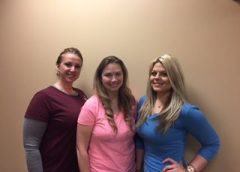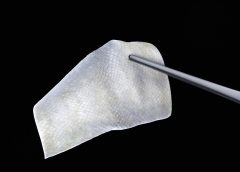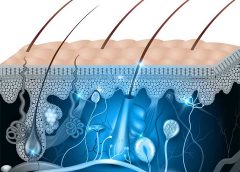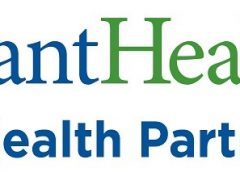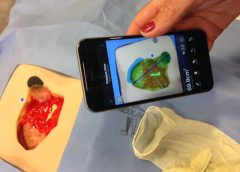Antibiotic overuse contributes to the problems of antibiotic resistance and healthcare acquired infections, such as Clostridium difficile. Antibiotic stewardship programs improve patient outcomes, reduce antimicrobial resistance, and save money. These programs are designed to ensure patients receive the right antibiotic, at the right dose, at the right time, and for the right duration. (more…)
Read MoreSearch Results for: Arte
Dragon blood may help wounds heal faster
A new study has identified a peptide, derived from the Komodo dragon, called VK25, which can be synthesized and used as an antimicrobial peptide to promote wound healing.
The new research has identified (see below) a peptide found from the Komodo dragon (Varanus komodoensis), called VK25, which appears to be useful as a cationic antimicrobial peptide (CAMP). There is currently considerable interest in antimicrobial peptides in a world where antibiotic effectiveness is in decline. These peptides are potent, broad spectrum antibiotics which demonstrate potential as novel therapeutic agents. (more…)
Read More2018 American Nurse Today Education Guide
Moving ahead with your nursing education
Deciding to continue your education is exciting as well as daunting. You’ll need support from your friends and family, as well as your colleagues and fellow students. But you also can get support from the nursing profession. In this article, you’ll find information about a variety of resources to aid you along this next step in your career.
[read more ->]
Ready, set, go… to school!
With 79.6% of employers now requiring or having a strong preference for nurses with a baccalaureate degree and a growing demand for nurses, there’s no better time to return to school.
[read more ->]
Frontiers of nursing education

Is an accelerated nursing program right for you?
Are you up for the challenge of an accelerated nursing program? You can earn your degree quickly and be off the races in your career, but these programs require dedication, self-discipline, and an ability to immerse yourself in the learning experience.
[read more ->]
Returning to nursing school? Keys to success

Ready to change specialties?
The opportunities within nursing are practically limitless. You can choose patient care, education, pharmaceutical sales, research…the list goes on and on. That’s part of the challenge. With so many choices, you need to know yourself and what you want as well as understand what will be required to get you to this next stage in your career.
[read more ->]
Lifelong Learning: Is a postmaster’s certificate the right option for you

Interprofessional education
Imagine the depth of knowledge you would gain by learning along side students in other healthcare disciplines. In education settings that embrace interprofessional education, students learn with, from, and about each other to enable effective communication and improve patient outcomes.
[read more ->]
Can nursing meet the 80/2020 goal?
In 2010, a goal was set to have 80% of nurses with BSNs by 2020. Read this article to find out what kind of progress we’ve made so far.
[read more ->]
Your doctorate and the path to persistence
High attrition rates for doctoral nursing students (reported to be as much as 50%) in the face of an increasing demand for PhD-prepared nursing faculty is a growing concern. So, what’s at the crux of this problem and how do we solve it? When I was a doctoral student, I researched how other doctoral students balanced work, family, and school. The goal was to learn more about the strategies used by these students.
[read more ->]2017-2018 Education Guide Read More
Three registered nurses pass National Wound Care course
Three registered nurses (RN) at Panhandle Home Health have passed the National Wound Care & Ostomy Certification Course & Exam (WCC) as part of Panhandle Home Health’s Wound Care Initiative, started in 2013 with a single WCC-certified RN, Cathy Reifer. In 2015, WISH (Women Investing in Shepherd) awarded their inaugural grant to a regional nonprofit, Panhandle Home Health. This grant of $26,250, along with additional private donations and grants, has allowed thirteen nurses to participate in the intensive, week-long training course. These RNs are prepared to provide specialized consultation and a unique supervisory level of clinical expertise in wound assessment and the specialized care involved for patients. Their training involves differentiation of wound types and the appropriate care; recognizing the effects of cancer, heart disease, diabetes, or COPD on wound healing; understanding care products and their implementation; wound-healing techniques; and patient education. (more…)
Read MoreA Conversation With the PJ Medical Director
Fish Skin for Human Wounds: Iceland’s Pioneering Treatment
The FDA-approved skin substitute reduces inflammation and transforms chronic wounds into acute injuries.
Six hours north of Reykjavik, along a narrow road tracing windswept fjords, is the Icelandic town of Isafjordur, home of 3,000 people and the midnight sun. On a blustery May afternoon, snow still fills the couloirs that loom over the docks, where the Pall Palsson, a 583-ton trawler, has just returned from a three-day trip. Below the rust-spotted deck, neat boxes are packed with freshly caught fish and ice. “If you take all the skins from that trawler,” says Fertram Sigurjonsson, the chairman and chief executive officer of Kerecis Ltd., gesturing over the catch, “we would be able to treat one in five wounds in the world.” (more…)
Read MoreSevere Burn Victims May Soon Be Able to Regrow Hair-Bearing Skin
PolarityTE (TM) Regenerates Full-Thickness Hair-Bearing Skin in Burns and Wounds Using Their Revolutionary Platform Technology. First ever known successful regeneration of full-thickness skin and hair; Company poised to initiate human trial in the third quarter of 2017; Management to host conference call Thursday, June 8th at 4:30pm ET.
Salt Lake City, UT — (Marketwired) — 06/08/17 — PolarityTE™, Inc. (NASDAQ: COOL) today announced pre-clinical results demonstrating that the Company’s lead product, SkinTE™, regenerated full-thickness, organized skin and hair follicles in third degree burn wounds. The findings represent the first known successful regeneration of skin and hair in full-thickness swine wound models, the standard animal model for human skin. The Company expects to initiate a human clinical trial evaluating the autologous homologous SkinTE™ construct in the third quarter of 2017. (more…)
Read MoreContributing to this website
Share your wound care insights and knowledge through WoundCareAdvisor.com
Consider contributing pertinent, useful information that health care professionals can utilize in the wound care practices
Sometimes we all think “It would be great to share this information with my peers”. WoundCareAdvisor.com invites you to do just that. . .share best practices, interesting case studies, practice information such as assessment techniques or documentation tips and more through our popular website. (more…)
Read MoreCovenant Health Wound Care Experts Earn National, Regional Recognition
LUBBOCK, TX (NEWS RELEASE) – The Covenant Center for Wound Care & Hyperbaric Medicine has been honored as a Wound Care Center® of the Year by Healogics, Inc., the nation’s leading and largest wound care management company. The center also was awarded Center of Distinction and the President’s Circle Award.
The center has achieved patient satisfaction rates higher than 92 percent, a healing rate of at least 91 percent in less than 31 median days and healed almost 90 percent of its patients in less than 14 weeks. Out of the 630 Centers eligible in 2016, only seven centers across the country received this prestigious award. Covenant’s center was awarded as Center of the Year for the southwest region, which includes Texas, Oklahoma, Louisiana and New Mexico. (more…)
Read MoreImaging technology to aid wound care
Nash UNC Health Care is continuing its effort to bring cutting-edge technology to the hospital.
Through a recent partnership with a Maryland-based medical imaging and data analytics company called Tissue Analytics, which is dedicated to revolutionizing wound care, Nash UNC Health Care has adopted new state-of-the-art wound imaging technology to its outpatient Wound Care Center. (more…)
Read MoreWound Care Swagger
By: Nancy Morgan, RN, BSN, MBA, WOCN, WCC, CWCMS, DWC
I was thrilled to be asked to write a blog for Wound Care Advisor. They asked me to come up with a name for the blog. I thought it would be easy… NOT ! I found myself doing all this research on how to make up a good name that would be catchy and memorable. I reached out to all my wound care friends for ideas and started a long list of names. Every morning I would look at this list and add more. Then I said I had to STOP THE INSANITY! I had to refocus and asked myself… who are you writing the blog for? It’s for people like me! I am a nurse that is in love with wound care, I have been in this field for almost two decades—ouch! that just dated me. I started at bedside then moved to an educator role co-founding the Wound Care Education Institute where we have taught over 16,000 clinicians, spreading the knowledge of Wound Care so they can make a difference in their patients’ lives. I am that person that “gets the rush” every time I see a wound. (more…)
Read MoreHow are you differentiating the “big three”?
BY: NANCY MORGAN, RN, BSN, MBA, WOCN, WCC, CWCMS, DWC
Lower extremity ulcers are often referred as the “big three”—arterial ulcers, venous ulcers, and diabetic foot ulcers. Are you able to properly identify them based on their characteristics? Sometimes, it’s a challenge to differentiate them.
Arterial ulcers tend occur the tips of toes, over phalangeal heads, around the lateral malleolus, on the middle portion of the tibia, and on areas subject to trauma. These ulcers are deep, pale, and often necrotic, with minimal granulation tissue. Surrounding skin commonly is pale, cool, thin, and hairless; toenails tend to be thick. Arterial ulcers tend to be dry with minimal drainage, and often are associated with significant pain. The patient usually has diminished or absent pulses. (more…)
Read More


